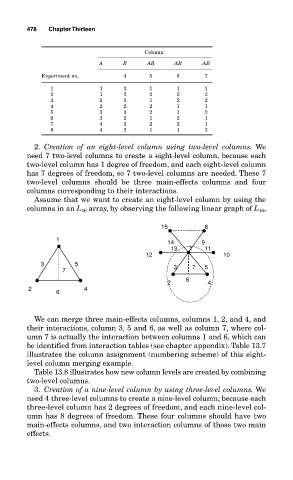Page 519 - Design for Six Sigma a Roadmap for Product Development
P. 519
478 Chapter Thirteen
Column
A B AB AB AB
Experiment no. 4 5 6 7
1 1 1 1 1 1
2 1 2 2 2 2
3 2 1 1 2 2
4 2 2 2 1 1
5 3 1 2 1 2
6 3 2 1 2 1
7 4 1 2 2 1
8 4 2 1 1 2
2. Creation of an eight-level column using two-level columns. We
need 7 two-level columns to create a eight-level column, because each
two-level column has 1 degree of freedom, and each eight-level column
has 7 degrees of freedom, so 7 two-level columns are needed. These 7
two-level columns should be three main-effects columns and four
columns corresponding to their interactions.
Assume that we want to create an eight-level column by using the
columns in an L 16 array, by observing the following linear graph of L 16 ,
15 8
1
14 9
13 1 11
12 10
3 5 3 7 5
7
6
2 4
2 4
6
We can merge three main-effects columns, columns 1, 2, and 4, and
their interactions, column 3, 5 and 6, as well as column 7, where col-
umn 7 is actually the interaction between columns 1 and 6, which can
be identified from interaction tables (see chapter appendix). Table 13.7
illustrates the column assignment (numbering scheme) of this eight-
level column merging example.
Table 13.8 illustrates how new column levels are created by combining
two-level columns.
3. Creation of a nine-level column by using three-level columns. We
need 4 three-level columns to create a nine-level column; because each
three-level column has 2 degrees of freedom, and each nine-level col-
umn has 8 degrees of freedom. These four columns should have two
main-effects columns, and two interaction columns of those two main
effects.

